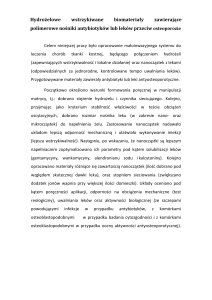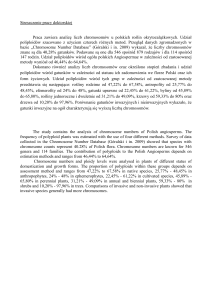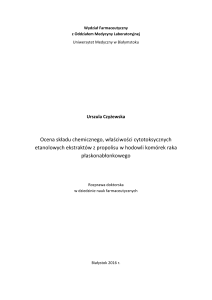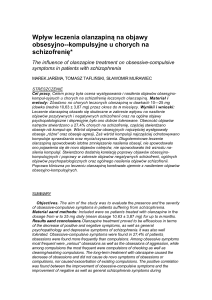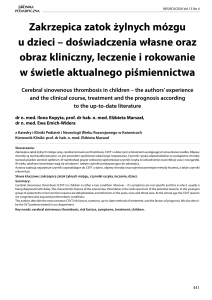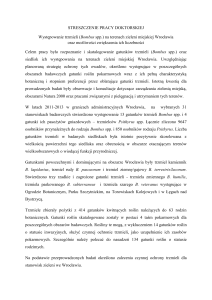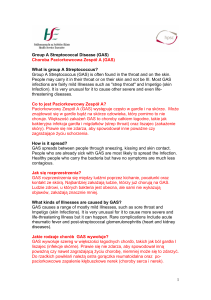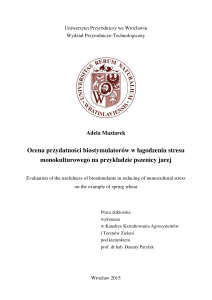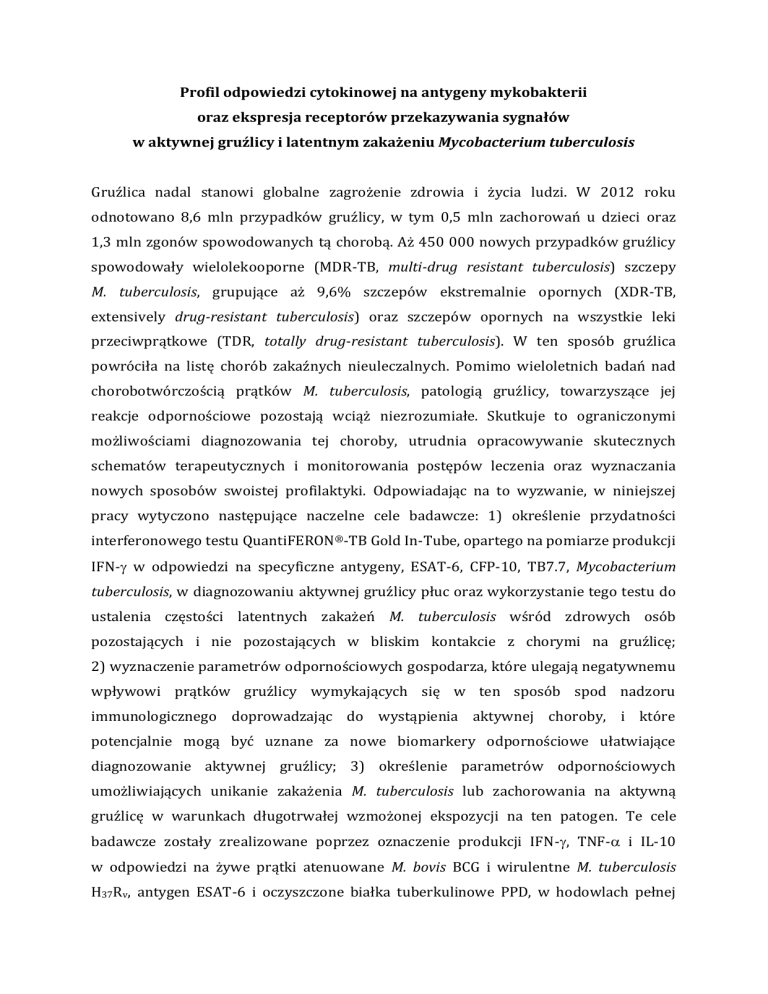
Profil odpowiedzi cytokinowej na antygeny mykobakterii
oraz ekspresja receptorów przekazywania sygnałów
w aktywnej gruźlicy i latentnym zakażeniu Mycobacterium tuberculosis
Gruźlica nadal stanowi globalne zagrożenie zdrowia i życia ludzi. W 2012 roku
odnotowano 8,6 mln przypadków gruźlicy, w tym 0,5 mln zachorowań u dzieci oraz
1,3 mln zgonów spowodowanych tą chorobą. Aż 450 000 nowych przypadków gruźlicy
spowodowały wielolekooporne (MDR-TB, multi-drug resistant tuberculosis) szczepy
M. tuberculosis, grupujące aż 9,6% szczepów ekstremalnie opornych (XDR-TB,
extensively drug-resistant tuberculosis) oraz szczepów opornych na wszystkie leki
przeciwprątkowe (TDR, totally drug-resistant tuberculosis). W ten sposób gruźlica
powróciła na listę chorób zakaźnych nieuleczalnych. Pomimo wieloletnich badań nad
chorobotwórczością prątków M. tuberculosis, patologią gruźlicy, towarzyszące jej
reakcje odpornościowe pozostają wciąż niezrozumiałe. Skutkuje to ograniczonymi
możliwościami diagnozowania tej choroby, utrudnia opracowywanie skutecznych
schematów terapeutycznych i monitorowania postępów leczenia oraz wyznaczania
nowych sposobów swoistej profilaktyki. Odpowiadając na to wyzwanie, w niniejszej
pracy wytyczono następujące naczelne cele badawcze: 1) określenie przydatności
interferonowego testu QuantiFERON®-TB Gold In-Tube, opartego na pomiarze produkcji
IFN- w odpowiedzi na specyficzne antygeny, ESAT-6, CFP-10, TB7.7, Mycobacterium
tuberculosis, w diagnozowaniu aktywnej gruźlicy płuc oraz wykorzystanie tego testu do
ustalenia częstości latentnych zakażeń M. tuberculosis wśród zdrowych osób
pozostających i nie pozostających w bliskim kontakcie z chorymi na gruźlicę;
2) wyznaczenie parametrów odpornościowych gospodarza, które ulegają negatywnemu
wpływowi prątków gruźlicy wymykających się w ten sposób spod nadzoru
immunologicznego doprowadzając do wystąpienia aktywnej choroby, i które
potencjalnie mogą być uznane za nowe biomarkery odpornościowe ułatwiające
diagnozowanie aktywnej gruźlicy; 3) określenie parametrów odpornościowych
umożliwiających unikanie zakażenia M. tuberculosis lub zachorowania na aktywną
gruźlicę w warunkach długotrwałej wzmożonej ekspozycji na ten patogen. Te cele
badawcze zostały zrealizowane poprzez oznaczenie produkcji IFN-, TNF- i IL-10
w odpowiedzi na żywe prątki atenuowane M. bovis BCG i wirulentne M. tuberculosis
H37Rv, antygen ESAT-6 i oczyszczone białka tuberkulinowe PPD, w hodowlach pełnej
krwi oraz oznaczenie ekspresji receptorów przekazywania sygnałów, mCD14 i TLR2 na
monocytach, markera CD3 na limfocytach T, integryny LFA-1 na monocytach
i limfocytach T oraz surowiczego stężenia rozpuszczalnej formy receptora sCD14,
w pięciu grupach badanych obejmujących 43 pacjentów z aktywną gruźlicą płuc,
46 chorych na ostre niemykobakteriowe zakażenia górnego układu oddechowego,
48 zdrowych długoletnich pracowników oddziałów gruźliczych, 41 zdrowych członków
rodzin chorych na TB oraz 46 zdrowych ochotników nie wykazujących w wywiadzie
kontaktów z chorymi na gruźlicę. Jako najważniejsze wyniki zrealizowanych badań
należy uznać: 1) wykazanie przydatności testu interferonowego w wykrywaniu
latentnych zakażeń M. tuberculosis oraz tylko pomocnej jego przydatności w szybkim
diagnozowaniu aktywnej gruźlicy, nie zwalniającej z obowiązku wykonania klasycznego
badania mikroskopowego i założenia hodowli, które pozostają nadal najbardziej
wiarygodną metodą diagnostyczną w gruźlicy; 2) pokazanie, że raczej ilościowa niż
jakościowa charakterystyka zespołu, a nie pojedynczej z badanych cytokin, IFN-, TNF-,
IL-10, produkowanych w odpowiedzi na rozpuszczalne i pełnokomórkowe antygeny
mykobakterii obrazuje status odpornościowy pacjentów z aktywną gruźlicą;
3)
wytypowanie
nadekspresji
błonowego
receptora
makrofagów
mCD14
z współwystępującą nasiloną ekspresją integryny LFA-1 na monocytach krwi
obwodowej, jako biomarkera odpornościowego aktywnej gruźlicy o potencjalnej
wartości aplikacyjnej w szybkim diagnozowaniu gruźlicy, zwłaszcza pacjentów,
u których nie udaje się wykazać obecności M. tuberculosis metodą bakterioskopii/
hodowli lub molekularną oraz w monitorowaniu osób z latentnym zakażeniem
M.
tuberculosis
zagrożonych
rozwojem
aktywnej gruźlicy;
4) wskazanie na
występowanie we krwi obwodowej pacjentów z aktywną gruźlicą dominacji monocytów
z silną ekspresją receptora TLR2high, i potencjalny jego udziału w przekazywaniu
negatywnego sygnału, którego skutkiem może być obserwowane u pacjentów
zahamowanie produkcji IFN- w odpowiedzi na atenuowane prątki M. bovis BCG
i spadkowa tendencja w zakresie częstości występowania nacieków limfocytarnych w
płucach oraz skórnej nadwrażliwości późnej na tuberkulinę; 5) określenie intensywnej
produkcji wszystkich trzech uwzględnionych w badaniach cytokin, IFN-, TNF-, IL-10,
w odpowiedzi na ESAT-6, specyficzny antygen M. tuberculosis, oraz nadekspresji
integryny LFA-1 na monocytach i limfocytach T, jako parametrów odpornościowych
ważnych w zapobieganiu zakażeniu M. tuberculosis i zachorowaniu na gruźlicę,
w warunkach długotrwałego kontaktu z pacjentami z aktywną gruźlicą.
The profile of mycobacterial antigen induced cytokine responses
and the expression of signal transduction receptors
in the active tuberculosis and latent infection with Mycobacterium tuberculosis
Tuberculosis remains a major global health problem and ranks as the second leading
cause of death from an infectious disease. In 2012, 8.6 million people including
0.5 million children developed tuberculosis and 1.3 million die from it. As many as
450 000 new tuberculosis cases caused MDR (multi-drug-resistant tuberculosis)
Mycobacterium tuberculosis strains among them 9.6% were estimated XDR (extensively
drug-resistant) and some TDR (total drug-resistant). In this way, tuberculosis returned
to the list of incurable diseases. Associated tuberculosis immune responses are still
unclear, despite many years of research of M. tuberculosis virulence and pathology of the
disease. This limits the diagnosis of tuberculosis, hinders the development of effective
therapeutic regimens and monitoring treatment progress, and new strategies for
specific prevention. Having regard to the problems outlined, it was decided:
1) to evaluate the usefulness of QuantiFERON-TB Gold In-Tube assay, that measures
the IFN-γ released from T cells responding to specific antigens (ESAT-6, CFP-10, TB.7.7)
of M. tuberculosis, for the diagnosis of tuberculosis in patients with active disease and to
examine the frequency of the latent M. tuberculosis infections in healthy subjects who
had or did not have a known contact with tuberculosis; 2) to identify the parameters of
the host immune system that are weakened by M. tuberculosis and allow bacilli to avoid
immune surveillance and lead to active disease, which could potentially be considered as
biomarkers useful for the diagnosis of active tuberculosis; 3) to determine the
parameters of host immunity that protect against infection with M. tuberculosis and
against the development of active tuberculosis during long-term exposure to
tuberculosis bacilli. Research objectives were achieved through a quantitative
assessment of the production of IFN-, TNF- and IL-10 in whole blood cultures
stimulated with live attenuated M. bovis BCG or virulent M. tuberculosis H37Rv bacilli,
ESAT-6 antigen and purified tuberculin proteins PPD, examining of the surface
expression of signal transduction receptors, mCD14 and TLR2 on monocytes, CD3
marker on T lymphocytes, LFA-1 integrin on monocytes and T lymphocytes and
determining the concentration of soluble form sCD14 receptor in the sera, for five
categories of volunteers. The study cohort comprises 43 patients with active pulmonary
tuberculosis, 46 patients with nonmycobacterial lung diseases, 48 healthy work contacts
and 41 household contacts of patients with active tuberculosis and 46 healthy
volunteers with no know tuberculosis contact. The most important results of completed
study should be considered: 1) the interferon-gamma release assay may serve as
a valuable screening test to identify individuals with latent M. tuberculosis infection and
this test might help in rapid diagnosis of active tuberculosis, however the individual
context of the patients should always be considered and the results must be confirmed
by M. tuberculosis culture, which remains the most reliable method of diagnosing
tuberculosis disease; 2) quantitative rather than a qualitative assessment of several
cytokines, IFN-, TNF-, IL-10, that are produced in the responses to soluble and whole
bacilli antigens reflects the immune status of patients with active tuberculosis;
3) a significant increase in the expression of the membrane bound mCD14 and LFA-1
receptors in patients with active tuberculosis may be a biomarker potentially useful in
the rapid diagnosis of patients from whom it is not possible to isolate M. tuberculosis and
in monitoring patients with latent M. tuberculosis infection who are at risk of developing
active disease; 4) a significant domination of TLR2high monocytes in the peripheral blood
of patients with active tuberculosis and the potential contribution of this receptor in the
transmission of a negative signal may at least partly explain inhibited IFN- response to
the attenuated M. bovis BCG and a downward trend in the frequency of lymphocytic
infiltrates in the lung and positive skin reactivity to tuberculin, which was observed in
patients with tuberculosis; 5) an intensive production of all three cytokines tested, IFN, TNF-, IL-10, in response to ESAT-6, the specific antigen of M. tuberculosis, and
overexpression of LFA-1 on monocytes and T lymphocytes can be considered as the
immune parameters important in preventing infection with M. tuberculosis and
developing active tuberculosis under prolonged contact with the pathogen.

